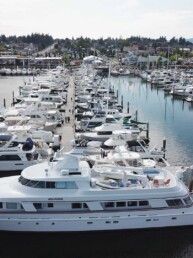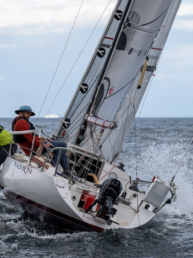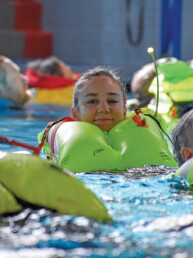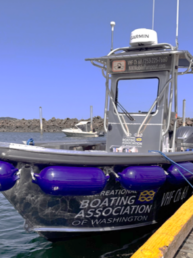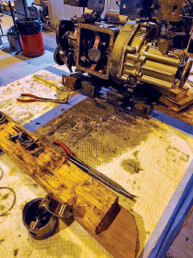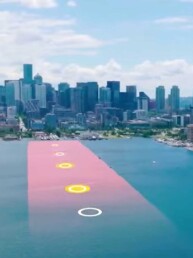The intricacies and rewards of sailing down the coast
Before dawn on a cool morning in late August, we slipped the dock lines and motored out of Elliott Bay Marina to join the Coho Ho Ho fleet on a voyage down the Pacific coast to San Francisco and beyond. Our crew of four watched the bright lights of Seattle fade behind us from the cockpit of the Beneteau Oceanis 45 with much excitement and not a little of trepidation. Making the turn north at West Point, we caught the start of the ebb tide running up Puget Sound and made good time with the current, gliding past the familiar landmarks of Kingston, Point No Point, Foulweather Bluff, and Port Townsend.
As organizers of the Coho seminar series and rally, we and the rest of our crew had been on the docks at Boat Haven Marina in Port Townsend a few days earlier for the official fleet sendoff. We asked for blessings from the gods of the winds and seas and ceremonially cut the last dock line holding the boats to the dock as they embarked on their adventures. Port Townsend is a convenient jumping off point with a grocery store and chandlery within easy walking distance from the marina, as well as lots of great shops, restaurants, and pubs to explore while waiting on favorable conditions to transit the Strait of Juan de Fuca.
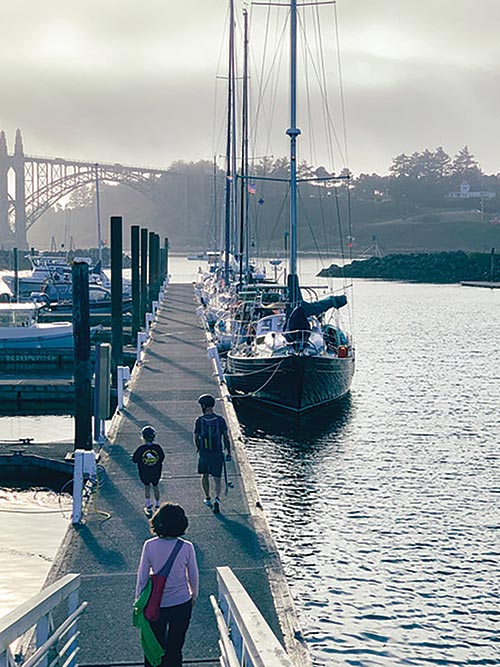
When it was our turn to head for the Strait, the forecast was for calm weather, so we motored past Point Wilson and turned the bow west to continue our outbound journey. A few hours later, we pulled into the fuel dock at Port Angeles to top up the tanks. It was a quick in-and-out for us, and we continued motoring west into a beautiful sunset.
We passed Neah Bay in the dark, shortly before midnight, and continued towards Cape Flattery to make the proverbial “Big Left Turn” into the Pacific Ocean. Many people anchor in the ample protection offered by Neah Bay to wait for good weather and rest up for the passage down the coast. If you spend a few days there, the fantastic Makah museum is a short walk from the marina; and if you’re passing through on a late August weekend, you can catch the Makah Days celebration.
Eager to make use of the gentle weather and excited to start making miles south, we passed Cape Flattery without ever seeing it as it was cloaked in fog and darkness. We swung wide around Tatoosh Island and set a course south toward our next planned stop in Newport, Oregon, being careful to stay well offshore to avoid the crab pots.
The easy up and down motion in the Strait had given way to a swell on the stern quarter, which resulted in the typical corkscrew motion of the boat in open ocean. One of our crew soon fell victim to the motion and retired to his bunk in hopes of relief.
I had the first night watch and kept an eye on the GPS and radar since there was zero visibility in the foggy dark. At 2 a.m., I handed the helm over to Captain Doug and turned in to get a little rest, hoping for wind in the morning so we could finally do some sailing. It had been a long first day and I fell into my bunk without bothering to take off my bibs.
Climbing back into the cockpit at 6 a.m., I found Doug still at the helm and our seasick crew member with his head over the side rail feeding the fish. The wind filled in as the sun rose behind the fog and we set sails on a broad reach south — this was more like it. While the sailing brought us joy, seeing our fellow sailor in dire straits slightly dampened our enthusiasm. All day, we plied our sick crewmate with ginger tea, soda crackers, and other hopeful remedies. None of us had ever really been seasick before and, unfortunately, we had not brought along any medications just in case.
By afternoon, our crewmate was showing no signs of improvement and the wind had backed to the southwest, so we decided to alter our offshore course plans to make for Westport, Washington.
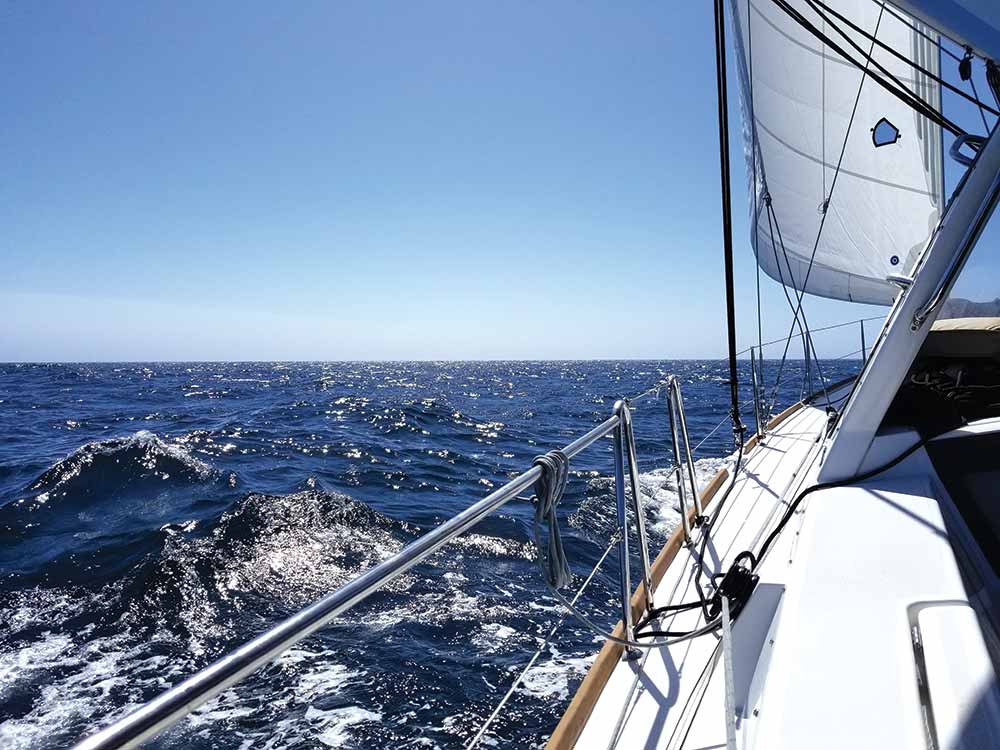
Fortunately, the conditions at the entrance bar to the harbor — with a dying flood before high slack — had wind, swell, and current all moving the same direction and afforded us an easy and safe crossing when we arrived. Even though we had originally planned on a route farther offshore, we had printed out the current tables for all the bars we might need to cross so we could make plans when out of cell phone range. Having information about potential bar crossings is crucial for anyone cruising down the West Coast; and it is important to remember that the interaction of the tides and the outflowing current from rivers means that slack current at the bars does not happen at the same time as the high and low tides in other nearby areas. It is unique to each bar crossing.
The entrance between the Westport jetties is wide and easy, and the large marina had plenty of available dock space. Within 10 minutes of tying up, our ailing crewmate was feeling chipper and wondering about the next meal. After dinner, we prowled the main drag by the marina, checking out gift shops and enjoying ice cream cones. In the morning, we scoured the town for seasickness meds, walked to the grocery store for a few goodies, and grabbed some more warm clothes from Englund Marine.
There was a good window with favorable currents to cross the bar that afternoon, so we cast off, motored past the sea lions that had taken over the end of the dock, and headed out over the bar and back out onto the ocean.
Our crewmate was feeling much better, there was a nice northwest wind for sailing, and we were all glad to be underway again. We spent the night tracking and avoiding the large ships entering and exiting the mouth of the Columbia River from all directions. The sun rose behind the fog again and we all fell into the rhythm of the boat rolling over the swells and rotation of watches at the helm.
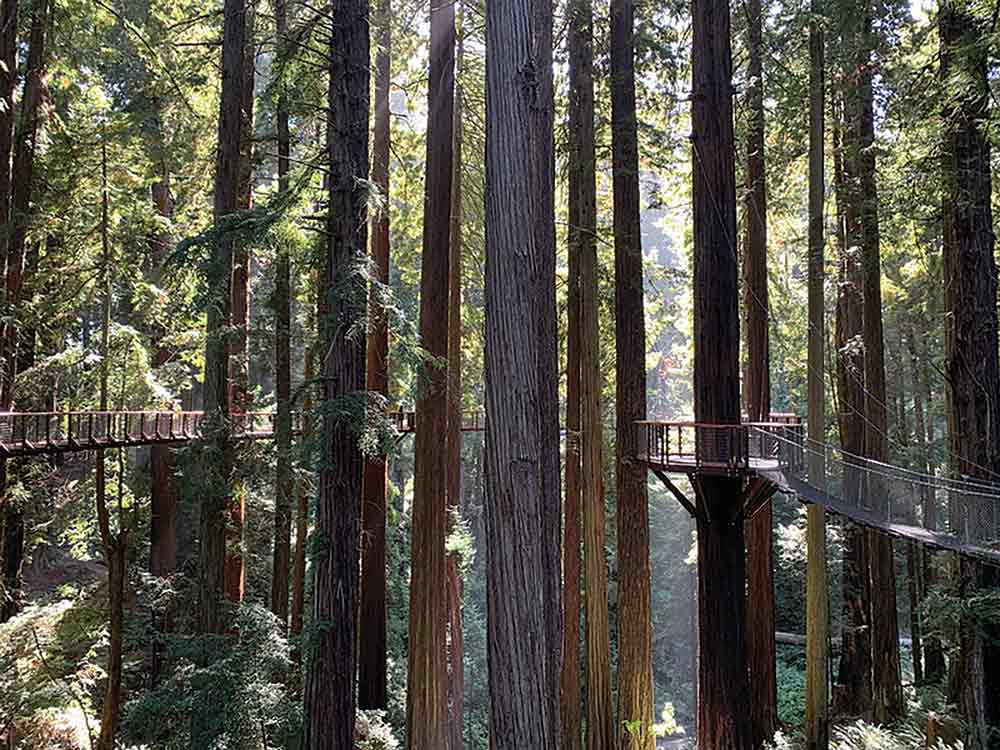
By the next afternoon, we could make out the beautiful arches of the bridge marking the entrance to Newport. Once again, we had timed our arrival with favorable conditions to cross the bar and were soon tied up at the marina and off for a quick pint at the Rogue Brewery, located conveniently next to the marina. In addition to an amazing selection of beers on tap that you will never find in stores, they offer a fascinating tour of their brewing operations.
The next morning, we took a quick cab ride across the bay to explore the shops and restaurants on Bay Boulevard. We visited another Englund Marine store and got two tuna trolling rigs, hoping that tuna sashimi was in our future. Soon, it was time to meet up with the fun folks at the Yaquina Bay Yacht Club for their weekly beer-can race and potluck, and we traded a Coho burgee for a YBYC burgee.
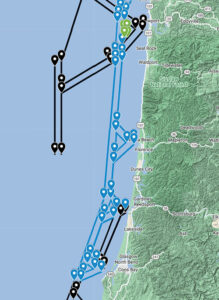
The weather forecast around Cape Blanco and Cape Mendocino was deteriorating, but it looked like there was time to sneak a little farther south to Coos Bay, Oregon. We had caught up with another boat from our Coho fleet, and together we headed out over the bar again. Instead of going offshore, we motored south inside the towboat lanes, a path free of crab pots that we had downloaded to Google Maps on our tablet. The crabber and towboat lane agreement has defined specific lanes along the coast from Neah Bay to San Francisco where tugs towing barges can operate free of crab pots. All we had to do was keep the little blue dot indicating our position in Google Maps in between the lines of the lanes.
After an easy overnight passage, we approached the bar at Coos Bay in the fog only to find a dredger in the middle of the channel. With AIS and radar, we could see each other despite the fog, and we passed them uneventfully on the way to the marina in Charleston, at the entrance to Coos Bay.
We were stuck in Charleston for almost five days waiting for the weather to turn favorable at the capes. We had plenty of company at the dock, as we caught up with more of the Coho fleet and other boats from the Salish Sea making their way south. We passed the time by exploring another unique coastal town and grabbing a taxi van with fellow sailors for trips into the town of Coos Bay, where we enjoyed outings to the classic movie theater and evenings at the 7 Devils Brewery, which had great beer and live music out on the patio.
Finally, a new forecast showed a brief window to sneak around the capes and we hurried to get the boat ready. We slipped out over the bar just before the current turned against us. Most of the other boats opted to wait for the next favorable window to cross the bar when the weather would be calmer; but Captain Doug knew that, if we crossed now, we would have just enough time to get past both capes before the next system closed in. This time, we set a course offshore and hoisted double reefed sails in the stiff wind.
As forecast, the winds eased after a few hours to a comfortable northwest 15 knots. By morning, we had bright sunshine and not long after deploying the tuna lines were rewarded — tuna for a delicious sashimi lunch and a seared tuna dinner! Throughout the entire journey, we made it a point to coordinate our watch schedule to allow for dinner together in the cockpit at sunset. Not only was this a pleasant experience, but we found it an easy way to touch base with each other to discuss lessons learned during the day and to plan for the night to come.
Other boats in the Coho fleet had taken refuge from the weather in various other ports south of us. A few had tucked into Bandon, Oregon, a lovely little town centered around the arts, where they enjoyed the easy walk to charming shops and restaurants. The bar there is a bit tricky, but there is a Coast Guard station next to the marina and they will come out and guide you in if requested.
Crescent City, California, is another popular stop, as it sits between Cape Blanco and Cape Mendocino, setting you up to scoot around in a short weather window. It does not have a bar crossing at the entrance, which makes timing your arrival less critical. There is good provisioning available, and a nice pub, but limited entertainment if you get stuck there for several days.
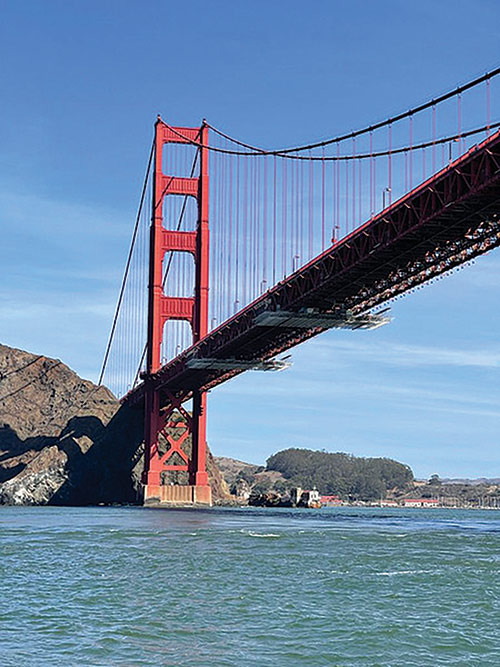
Eureka, California, is a short day farther south, and is a charming town known for having more than 100 murals on the buildings to go along with its hippie vibe. It does have a bar crossing at the entrance, so timing is essential when arriving and departing. There are two marinas in Humboldt Bay to choose from. An amazing organic co-op grocery is nearby, as well as a zoo with a set of hanging bridges connecting a grove of sequoia trees growing inside. Many sailors waiting for weather windows in Eureka rent cars to visit the majestic sequoia trees in nearby Redwood National Park. Notably, there is also a NOAA office near the marina, so the forecasts tend to be quite accurate for that area.
Coho boats past the capes have also tucked into Bodega Bay, California, which is sheltered and full of wildlife, but has few amenities within walking distance. There is some guest moorage at the small marina as well as anchorage outside the main channel.
Drakes Bay is a stone’s throw from the entrance to San Francisco and offers a good place to duck out of heavy weather and to avoid entering San Francisco Bay in the dark. It is sheltered from northerlies and has good holding behind Point Reyes Head.
As any southbound sailor can attest, no two passages between the Salish Sea and San Francisco are the same. All of these port options for coastal cruisers can help break up a voyage, especially if weather or crew needs and desires dictate. They allow for respite and recuperation, and also give cruisers a chance to explore some truly charming and unique surroundings. To us, knowing they’re available makes cruising down the coast seem a little more accessible.
After a couple days of lovely offshore sailing out past the fog line, we jibed back towards shore and set a course for San Francisco. The payoff from all the night watches, bar crossings, and waiting on weather windows was the unbelievable sensation of sailing under the Golden Gate Bridge and into San Francisco Bay. We tied up at Schoonmaker Marina in Sausalito, stripped off our foulies, and enjoyed the warm sun before meeting up with fellow crews for a celebratory meal together. For our boat and others, it was truly great to be there.
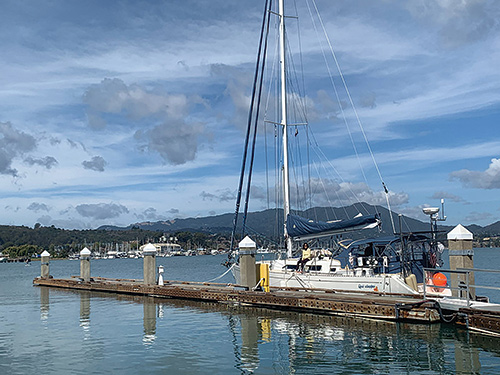
Bob Vizenor and Doug Lombard are co-owners of the Coho Ho Ho. Bob and his wife Pam split their time between their twin Slocum 43s in Puget Sound and Puerto Vallarta Mexico. Doug is the founder of the Coho, a racer, a licensed captain, and sailing instructor who teaches on all sizes of boats from Alaska to the US Virgin Islands.
Feature image courtesy of Maciek Sarnowicz (svquevendra.voyage).
If you are considering making a voyage down the coast to San Francisco, San Diego, and beyond, the Coho Ho Ho is a great resource for information and a way to meet other like-minded sailors. The Coho offers a series of 13 seminars on various topics including weather forecasting, offshore communication, first aid at sea, and more. Before each seminar there is a potluck where sailors can get to know each other and share plans, projects, and stories. Learn more at cohohoho.com.

